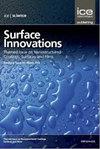柔性SiO2-TiO2纳米纤维膜增强亚甲基蓝染料的降解
IF 3.5
4区 材料科学
Q3 CHEMISTRY, PHYSICAL
引用次数: 1
摘要
二氧化钛(TiO2)被认为是应用最广泛的光催化半导体材料之一。然而,传统的粉状二氧化钛存在一定的局限性,包括相对较弱的光吸收能力、较小的表面积和活性位点不足。本研究通过静电纺丝技术和煅烧工艺成功制备了柔性多孔二氧化硅-二氧化钛纳米纤维膜。多孔膜在水处理中表现出卓越的性能,具有高比表面积(49 m2/g)和孔隙率,能够有效吸附和去除水中的有机污染物。值得注意的是,NFMs-800变体表现出出色的光催化性能,在紫外线照射下完全去除吸附的有机化合物。这种多孔膜的设计和制造方法简单,可扩展,为实际水处理应用提供了潜在的解决方案。因此,二氧化硅-二氧化钛多孔膜在水处理领域具有重要的前景,为实现高效和可持续的水资源管理提供了有希望的贡献。本文章由计算机程序翻译,如有差异,请以英文原文为准。
Enhanced degradation of methylene blue dye using flexible SiO2–TiO2 nanofiber membranes
Titanium dioxide (TiO2) is widely regarded as one of the most extensively applied photocatalytic semiconductor materials. However, conventional powdered titanium dioxide exhibits certain limitations, including relatively weak light absorption capability, a small surface area and insufficient active sites. This study successfully prepared flexible and porous silicon dioxide (SiO2)–titanium dioxide nanofiber membranes (NFMs) by implementing electrospinning technology and calcination processes. The porous membranes demonstrate remarkable performance in water treatment, featuring a high specific surface area (49 m2/g) and porosity, enabling efficient adsorption and removal of organic pollutants in water. Remarkably, the NFMs-800 variant exhibits outstanding photocatalytic performance, achieving complete removal of adsorbed organic compounds under ultraviolet irradiation. The design and fabrication methods of this porous membrane are simple and scalable, providing a potential solution for practical water-treatment applications. Consequently, the silicon dioxide–titanium dioxide porous membrane holds significant prospects in the field of water treatment, offering a promising contribution to the attainment of efficient and sustainable water resource management.
求助全文
通过发布文献求助,成功后即可免费获取论文全文。
去求助
来源期刊

Surface Innovations
CHEMISTRY, PHYSICALMATERIALS SCIENCE, COAT-MATERIALS SCIENCE, COATINGS & FILMS
CiteScore
5.80
自引率
22.90%
发文量
66
期刊介绍:
The material innovations on surfaces, combined with understanding and manipulation of physics and chemistry of functional surfaces and coatings, have exploded in the past decade at an incredibly rapid pace.
Superhydrophobicity, superhydrophlicity, self-cleaning, self-healing, anti-fouling, anti-bacterial, etc., have become important fundamental topics of surface science research community driven by curiosity of physics, chemistry, and biology of interaction phenomenon at surfaces and their enormous potential in practical applications. Materials having controlled-functionality surfaces and coatings are important to the manufacturing of new products for environmental control, liquid manipulation, nanotechnological advances, biomedical engineering, pharmacy, biotechnology, and many others, and are part of the most promising technological innovations of the twenty-first century.
 求助内容:
求助内容: 应助结果提醒方式:
应助结果提醒方式:


